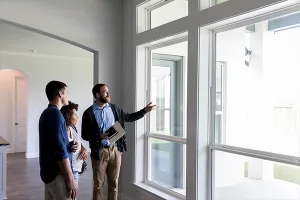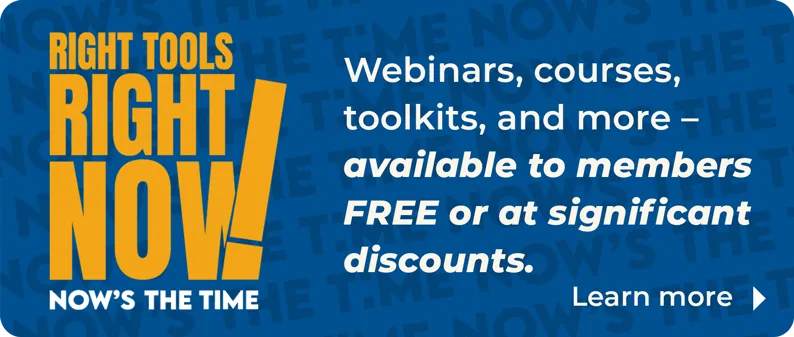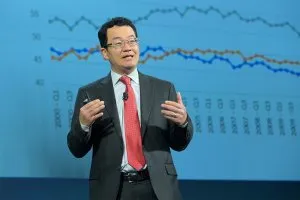Kicking off the DISRUPTION IS NOT A DIRTY WORD panel of innovative new technology companies operating in the commercial real estate space was RPR® VP Emily Line, who introduced Turner Levison of CommissionTrac, Vishu Ramanathan of Buildout, Greg Ausley of CoachSimple™, and Sanjay Kuttemperoor of WikiRealty
Disruption is a word we see used all the time, but the panel gathered in the Commercial Learning Theater at the Expo decided to define it in different ways. Line feels disruption is vital: “Te future of our industry is about finding simple solutions that enable the practitioner to more efficiently, eloquently, and elegantly articulate data for their clients.”
Turner Levison, whose CommissionTrac helps brokers with transparency and faster payment, saw disruption as “giving an enterprise solution previously only available to the biggest of the big” to groups numbering in the hundreds. Vishu Ramanathan who heads up Buildout, a marketing platform especially for commercial brokers, said true disruption occurs when “you get everybody in the ecosystem sharing their information and putting it out there.”
Sanjay Kuttemperoor’s WikiRealty is based on the premise that hyperlocal, granular information about neighborhoods married with listing data helps clients with site selection. His definition of disruption was “something that completely changes the market.” Levison added one result of disruption: “From 1955 to 2005, only 15% of the Fortune 500 are still there. From 2000 to 2015 there’s less than half.”
Greg Ausley’s CoachCimple™ encourages coaches, managers, and executives to promote a coaching culture and guide professionals through all stages of the success lifecycle. In order to avoid being eliminated by disruptive technology, Ausley believes “the key for commercial brokers is to try and stay on top of technology and reuse of property to ft new trends.”
Even though perspectives and offerings differed, all the panelists agreed: change happens – whether you fear it or you don’t
The FUTURE OF LAND INVESTMENT presentation by Bob Turner, ALC, hammered home a point that may be shocking: Location, location, location isn’t the rule in land any longer. It’s location and timing – and timing might be more important
Turner embellished this idea at his talk on investing in land in the future, given in the Commercial Learning Teater at the Expo.
“We used to work on ten year trends,” said Turner. “But since the 2008 crash, I’ve identified in my business that every cycle is a two year cycle.”
Tis accelerated rate of change means that investing profitably requires the opposite of the traditional location-based projections and “fre-and-forget” investment.
Turner spoke of a big development in Memphis that follows the new rule. Its full construction schedule is pegged at six years, which to Turner means it spans three steep cycles in land prices. The answer: “We break down the development into six phases. We’ll put in roads and infrastructure, but what a parcel of the project will ultimately be developed to be is decided much later.”
To Turner, doing it this way is akin to a win-win: “If the price (of land) goes up, we do very well. If the price goes down, we do okay.”
Curry talked in the Commercial Learning Teater at the Expo about the new ecosystem of live data measuring building performance now flowing from inexpensive, new-generation sensors that communicate to building owners and managers over the internet. Tese devices report on an ever-widening number of statistics, including temperature, foot trafc, and even the freshness of air – as measured by taking readings of the CO2 gas levels in targeted rooms. From his lab, Curry reports the internet of things is coming to commercial real estate in a big way. To keep an eye on this giant set of changes, click over to crtlabs.com and keep up with the Bits & Bytes blog.
1031 EXCHANGE SOLUTIONS & INVESTING IN PRIVATE PLACMENTS was led by Inland’s Jackie Barbera, who guided an interactive session on this hot topic. IRS Section 1031 is a capital gains tax shelter, originally created in the 1920s to benefit farmers, and it is responsible for a great deal of real estate transaction volume where property is exchanged, on a special timetable, for property of a “like kind” using a qualified intermediary (QI).
What’s a QI and why is one necessary? Under 1031, the seller cannot receive nor control the net sale proceeds, and so must make use of a third party to serve as an intermediary. As this part of the industry is not regulated, great care must be taken to select a trustworthy QI. Barbera told the story of a half-million dollar 1031 transaction where a shady QI had placed the funds in an investment that tanked over the weekend, forcing a loss on the seller, who could only recover 85 cents on the dollar.
In a very animated Q&A session, it came up that 1031 exchanges can only apply to domestic properties. Tey are recognized, says Barbera, by all states except Pennsylvania. Puerto Rico also does not recognize them, though the US Virgin Islands does.
“I always liked buildings. I was the kid in the backyard making things out of mud and sticks,” said Nancy Surak. I went in [to commercial real estate] knowing I might not make a dime.” One year after getting her start she closed her first contract. Tat was the “aha” moment: “I don’t live off what I make, I live off what I made the previous year — so I bought myself two and a half years in the business the day that contract closed.”
Panelist Jessica Gauldin talked of her “Aha!” moment early in her commercial career: “I took every deal, whether 200 or 2,000 square feet, I got it and worked it. Because of that, the deals were getting done fast.”
Las Vegas’s Soozi Jones-Walker, CCIM, SIOR told of her early days: “From 1984 to ‘86, I took CCIM classes because I knew I didn’t want to sell residential.” Working commercial in a Coldwell Banker at that time might have given her a leg up, but when Coldwell became CBRE, she was overlooked. “CBRE hired all the men from my southern Nevada ofce.”
Overcoming discrimination was just the beginning for Jones-Walker, who went on to a distinguished career including top sales, committee appointments with CCIM and SIOR, and too many awards to count. It’s fair to say CBRE didn’t know what they were missing.
Several attendees arrived a few minutes late to WHY YOU NEED TO KNOW ABOUT WALKABLE COMMUNITIES, likely because walkability around the Orlando Convention Center is not quite what it could be. Endless traffic signals favoring cars over pedestrians was the issue outside, as well as one of the key problems on the table at this session, kicked off by Kelly Morphy of the Walkable and Livable Communities Institute (walklive.org).
Attendees learned concepts and jargon of walkability advocates, including “road diet”, a transportation planning technique where the effective width of a road is reduced in order to improve its walkability. Morphy’s preference for bike lanes and sidewalks is in the pursuit of successful development, under the premise that private investment will come as long as the appropriate public investment is made.
Walkability is not just more equitable to populations, it’s also profitable, said second speaker Christopher Coes (locusdevelopers.org), showing a slide spelling out that a rent premium of 72% is enjoyed by walkable urban real estate product in the 30 largest metros over rents in drivable suburban areas. Keeping a balance between walking and driving in urban development not only gets people to their convention sessions on time – it pays the bills as well.
Scott Muldavin and Peter Burley’s session TOP TEN ISSUES AFFECTING COMMERCIAL REAL ESTATE was a walkthrough of the big issues facing commercial property markets – many of which pointed to the continuing compression of the middle class as a major restrictor of growth. Income distribution loomed large in their #7 issue, “Te Disappearing Middle Class”, where they took a look at the commercial impact of middle market retail contraction, citing Sears and Macy’s closures as major trouble spots. Associated with that contraction, said the pair, were heightened opportunities in high-density multi-family housing, and low-end retail (Walmart, dollar stores).
In the lively and interactive session attended by hundreds, a show of hands was given on the question of a rise in the national minimum wage. Slightly more than half of attendees agreed that the minimum wage should rise to address the persistent problems of a populace that cannot afford to move or own due to shrinking purchasing power.








